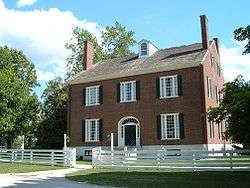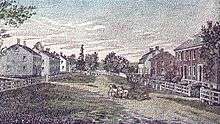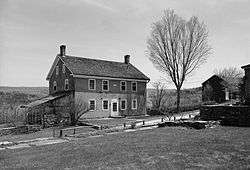Shaker communities
 |
| Topics |
|---|
|
| Notable people |
|



Shaker communities were established in the United States beginning in 1784 in the New England states and then spread to the Midwestern states. Communities of Shakers were governed by area bishoprics and within the communities individuals were grouped into "family" units and worked together to manage daily activities. As the number of living Shakers diminished, Shaker villages ceased to exist. Some of their buildings became historic districts under the National Register of Historic Places and museums, such as the Shaker Museum and Library, now called Shaker Museum|Mount Lebanon, in New York.
The only active community is Sabbathday Lake Shaker Village in Maine.
The first Shaker societies
The Shaker community north of Albany was first called "Niskayuna." Later the town they were in was officially named Watervliet. That part of the town of Watervliet is now in the town of Colonie (since 1895), and the name Watervliet is now limited to the city of Watervliet (1896). In addition, Niskayuna is now the name of a town to the northwest. This has led to some confusion, because many historical accounts refer to them as the Niskayuna Shakers, while others refer to them as Watervliet Shakers. The Watervliet Shaker Historic District is where Mother Ann Lee was buried.[1]
Settlement growth
The Shakers built more than 20 settlements that attracted at least 20,000 converts over the next century.[2] Strict believers in celibacy, Shakers acquired their members through conversion, indenturing children, and adoption of orphans. Some children, such as Isaac N. Youngs, came to the Shakers when their parents joined, then grew up to become faithful members as adults.[3]
As their communities grew, women and men shared leadership of the Shaker communities. Women preached and received revelations as the Spirit fell upon them. Thriving on the religious enthusiasm of the first and second Great Awakenings, the Shakers declared their messianic, communitarian message with significant response. One early convert observed: “The wisdom of their instructions, the purity of their doctrine, their Christ-like deportment, and the simplicity of their manners, all appeared truly apostolical.” The Shakers represent a small but important Utopian response to the gospel. Preaching in their communities knew no boundaries of gender, social class, or education.[4]
Village organization
Bishoprics
Shaker communities were grouped into bishoprics, which were governing units. A ministry resided in the bishopric's primary community. The New Lebanon Bishopric, the primary bishopric unit, was located in New York and included the Mount Lebanon Shaker Society and the Watervliet Shaker Villages.[5]
Family groups
A Shaker village was divided into groups or "families." The leading group in each village was the Church Family, and it was surrounded by satellite families that were often named for points on the compass rose. Each village was governed by a leadership team consisting of two men (Elders) and two women (Eldresses). Shakers lived together as brothers and sisters. Each house was divided so that men and women did most things separately. They used different staircases and doors. They sat on opposite sides of the room in worship, at meals, and in "union meetings" held to provide supervised socialization between the sexes. However, the daily business of a Shaker village required the brethren and sisters to interact. Though there was a division of labor between men and women, they also cooperated in carrying out many tasks, such as harvesting apples, food production, laundry, and gathering firewood.[6]
Every family was designed to be self-supporting with its own farm and businesses, but in times of hardship, other Shaker villages pitched in to help the afflicted.
Communities
| Image | Site | Spiritual name[7] | Bishopric[5][8] | City | State | Dates | Historic designation |
|---|---|---|---|---|---|---|---|
 | Alfred Shaker Historic District | Holy Land | Alfred[nb 1] | Alfred | Maine | 1793-1931[9][10] | NRHP[11][nb 2] |
 | Canterbury Shaker Village | Holy Ground | Canterbury | Canterbury | New Hampshire | 1792-1992[12][13] | NRHP[11] |
| | Enfield Shaker Historic District | Chosen Vale | Canterbury | Enfield | New Hampshire | 1793-1923[14][15] | NRHP[11] |
 | Enfield Shakers Historic District | City of Union | Hancock | Enfield | Connecticut | 1792-1917[16][17] | NRHP[11] |
 | Groveland Shaker Village | Union Branch | Groveland[nb 3] | Groveland | New York | 1836-1892[18] | |
.jpg) | Hancock Shaker Village | City of Peace | Hancock | Pittsfield | Massachusetts | 1790-1960[19] | NRHP[11] |
 | Harvard Shaker Village Historic District | Lovely Vineyard | Harvard | Harvard | Massachusetts | 1792-1918[20][21] | NRHP[11] |
 | Mount Lebanon Shaker Society | Holy Mount | New Lebanon | New Lebanon | New York | 1785-1917[22] | NRHP[11] |
 | North Union Shaker Site | Holy Grove | North Union[nb 4] | Cleveland | Ohio | 1822-1899[23] | NRHP[11] |
 | Sabbathday Lake Shaker Village | Chosen Land | Alfred[nb 1] | New Gloucester | Maine | 1794-present[24][25] | NRHP[11] |
 | Shakertown at Pleasant Hill Historic District | None | Pleasant Hill[nb 4] | Harrodsburg | Kentucky | 1806-1910[26][27] | NRHP[11] |
 | Shirley Shaker Village | Pleasant Garden | Harvard | Shirley | Massachusetts | 1793-1908[28][29] | NRHP[11] |
| Sodus Bay Shaker Tract | Unknown / None | Unknown | Alton | New York | 1826-1836[30] | ||
 | South Union Shakertown Historic District | Jasper Valley | South Union[nb 4] | South Union | Kentucky | 1807-1922[31][32] | NRHP[11] |
 | Tyringham Shaker Settlement Historic District | City of Love | Hancock | Tyringham | Massachusetts | 1792-1875[33][34] | NRHP[11] |
 | Union Village Shaker settlement | Wisdom's Paradise | Union Village[nb 4] | Turtlecreek Township | Ohio | 1805-[35][36] | |
 | Watervliet Shaker Historic District | Wisdom's Valley | New Lebanon | Albany | New York | 1774-1926[37] | NRHP[11] |
| Watervliet Shaker Village | Vale of Peace | Union Village [nb 4] | Kettering | Ohio | 1806-1900[35][38] | Historical marker[39] | |
| West Union Shaker village | None | Union Village | West Union (Busro) | Indiana | 1807-1827[40] | ||
 | Whitewater Shaker Settlement | Lonely Plain of Tribulation | Whitewater [nb 4] | New Haven | Ohio | 1822-1916[35][41] | NRHP[11] |
Shaker village tourism
In the 19th century, hundreds of tourists visited Shaker villages, and many of them later wrote about their experiences there. Outsiders were invariably impressed by Shaker cleanliness, prosperity, and agriculture. Shaker food was delicious, and they were hospitable to outsiders. Shakers had a reputation for honesty and their products were the best of their kind.[42]
Museums
- Alfred Shaker Museum, Kettering, Ohio
- Enfield Shaker Museum, Enfield, New Hampshire
- Fruitlands Museum, Harvard, Massachusetts
- Shaker Historical Museum, Shaker Heights, Ohio
- Shaker Museum and Library, New Lebanon, New York
- Shaker Museum at South Union, Auburn, Kentucky
Notes
- 1 2 The Alfred Bishopic was placed under the Canterbury Ministry from 1830 to 1859.[5]
- ↑ NRHP - National Register of Historic Places
- ↑ Groveland came under New Lebanon after 1859.[5]
- 1 2 3 4 5 6 After 1862, North Union fell under Union Village. After 1889, Union Village oversaw all societies in Kentucky and Ohio. [5]
References
- ↑ Stephen J. Stein, The Shaker Experience in America (1992) pp 10–37
- ↑ Priscilla Brewer, Shaker Communities, Shaker Lives (Hanover, N.H.: University Press of New England, 1986), xx; Stephen J. Stein, The Shaker Experience in America, 114.
- ↑ Glendyne R. Wergland, One Shaker Life: Isaac Newton Youngs, 1793–1865 (Amherst: University of Massachusetts Press, 2006), chapter 2.
- ↑ Michael Duduit, Handbook of Contemporary Preaching (Nashville, TN: Broadman Press, 1992). 32–33.
- 1 2 3 4 5 Stephen J. Paterwic. Historical Dictionary of the Shakers. Scarecrow Press; 11 August 2008. ISBN 978-0-8108-6255-5. p. 18.
- ↑ Stein, The Shaker Experience in America p. 94.
- ↑ Stephen J. Stein. The Shaker Experience in America: A History of the United Society of Believers. Yale University Press; 1 February 1994. ISBN 978-0-300-05933-5. p. 181.
- ↑ Stephen J. Paterwic. The A to Z of the Shakers. Scarecrow Press; 28 September 2009. ISBN 978-0-8108-7056-7. p. 235.
- ↑ Alfred Shaker Historic District. Shaker Historic Trail. National Park Service. Retrieved March 25, 2014.
- ↑ Stephen J. Paterwic. Historical Dictionary of the Shakers. Scarecrow Press; 11 August 2008. ISBN 978-0-8108-6255-5. p. 2.
- 1 2 3 4 5 6 7 8 9 10 11 12 13 14 15 List of Sites. Shaker Historic Trail: National Register of Historic Places Travel Itinerary. Retrieved March 27, 2014.
- ↑ Canterbury Shaker Village. Shaker Historic Trail. National Park Service. Retrieved March 25, 2014.
- ↑ Stephen J. Paterwic. The A to Z of the Shakers. Scarecrow Press; 28 September 2009. ISBN 978-0-8108-7056-7. p. 29.
- ↑ Enfield Shaker Historic District. Shaker Historic Trail. National Park Service. Retrieved March 25, 2014.
- ↑ Stephen J. Paterwic. The A to Z of the Shakers. Scarecrow Press; 28 September 2009. ISBN 978-0-8108-7056-7. p. 65.
- ↑ Enfield Shakers Historic District. Shaker Historic Trail. National Park Service. Retrieved March 25, 2014.
- ↑ Stephen J. Paterwic. The A to Z of the Shakers. Scarecrow Press; 28 September 2009. ISBN 978-0-8108-7056-7. p. 63.
- ↑ Stephen J. Paterwic. The A to Z of the Shakers. Scarecrow Press; 28 September 2009. ISBN 978-0-8108-7056-7. p. 96.
- ↑ Stephen J. Paterwic. The A to Z of the Shakers. Scarecrow Press; 28 September 2009. ISBN 978-0-8108-7056-7. p. 101.
- ↑ Harvard Shaker Village. Shaker Historic Trail. National Park Service. Retrieved March 25, 2014.
- ↑ Stephen J. Paterwic. The A to Z of the Shakers. Scarecrow Press; 28 September 2009. ISBN 978-0-8108-7056-7. p. 104.
- ↑ Mount Lebanon Shaker Society. Shaker Historic Trail. National Park Service. Retrieved March 25, 2014.
- ↑ North Union Shaker Site. Shaker Historic Trail. National Park Service. Retrieved March 25, 2014.
- ↑ Sabbathday Lake Shaker Village. Shaker Historic Trail. National Park Service. Retrieved March 25, 2014.
- ↑ Stephen J. Paterwic. The A to Z of the Shakers. Scarecrow Press; 28 September 2009. ISBN 978-0-8108-7056-7. p. xx.
- ↑ Shakertown at Pleasant Hill Historic District. Shaker Historic Trail. National Park Service. Retrieved March 25, 2014.
- ↑ Stephen J. Paterwic. The A to Z of the Shakers. Scarecrow Press; 28 September 2009. ISBN 978-0-8108-7056-7. p. 174.
- ↑ Shirley Shaker Village. Shaker Historic Trail. National Park Service. Retrieved March 25, 2014.
- ↑ Stephen J. Paterwic. The A to Z of the Shakers. Scarecrow Press; 28 September 2009. ISBN 978-0-8108-7056-7. p. 191.
- ↑ Stephen J. Paterwic. The A to Z of the Shakers. Scarecrow Press; 28 September 2009. ISBN 978-0-8108-7056-7. p. 197.
- ↑ South Union Shakertown Historic District. Shaker Historic Trail. National Park Service. Retrieved March 25, 2014.
- ↑ Stephen J. Paterwic. The A to Z of the Shakers. Scarecrow Press; 28 September 2009. ISBN 978-0-8108-7056-7. p. 201.
- ↑ Tyringham Shaker Settlement Historic District. Shaker Historic Trail. National Park Service. Retrieved March 25, 2014.
- ↑ Stephen J. Paterwic. The A to Z of the Shakers. Scarecrow Press; 28 September 2009. ISBN 978-0-8108-7056-7. p. 218.
- 1 2 3 Whitewater Shaker Settlement. Shaker Historic Trail. National Park Service. Retrieved March 25, 2014.
- ↑ Stephen J. Paterwic. The A to Z of the Shakers. Scarecrow Press; 28 September 2009. ISBN 978-0-8108-7056-7. p. xxi.
- ↑ Watervliet Shaker Historic District. Shaker Historic Trail. National Park Service. Retrieved March 25, 2014.
- ↑ Stephen J. Paterwic. The A to Z of the Shakers. Scarecrow Press; 28 September 2009. ISBN 978-0-8108-7056-7. p. 229.
- ↑ Marker #6-57 Watervliet Shaker Community. Remarkable Ohio: Marking Ohio's History. The Ohio Historical Society. Retrieved March 26, 2014.
- ↑ Stephen J. Paterwic. The A to Z of the Shakers. Scarecrow Press; 28 September 2009. ISBN 978-0-8108-7056-7. p. 235.
- ↑ Stephen J. Paterwic. The A to Z of the Shakers. Scarecrow Press; 28 September 2009. ISBN 978-0-8108-7056-7. p. xxi, xxiii.
- ↑ Glendyne R. Wergland, Visiting the Shakers, 1778–1849; Glendyne R. Wergland, Visiting the Shakers, 1850–1899 (Clinton, N.Y.: Richard W. Couper Press, 2010).
Further reading
- Brewer, Priscilla. Shaker Communities, Shaker Lives. Hanover, N.H.: University Press of New England, 1986.
- Brewer, Priscilla. "The Shakers of Mother Ann Lee," in America's Communal Utopias ed. by Donald E. Pitzer. (1997) pp. 37–56.
- Burns, Deborah E. Shaker Cities of Peace, Love, and Union: A History of the Hancock Bishopric. U. Press of New England, 1993. 246 pp.
- Foster, Lawrence. Women, Family, and Utopia: Communal Experiments of the Shakers, the Oneida Community, and the Mormons (1991).
- Gutek, Gerald and Gutek, Patricia. Visiting Utopian Communities: A Guide to the Shakers, Moravians, and Others. U. of South Carolina Press, 1998. 230 pp.
- Kelly, Andrew. Kentucky by Design: The Decorative Arts and American Culture, with an Emphasis on the Shaker Communities at Pleasant Hill and South Union. University Press of Kentucky, 2015. ISBN 978-0-8131-5567-8
- Murray, John E. “A Demographic Analysis of Shaker Mortality Trends.” Communal Societies. Volume 13 (1993): 22–44.
- Murray John E. "Determinants of Membership Levels and Duration in a Shaker Commune, 1780–1880". Journal for the Scientific Study of Religion 34 (1995): 35–48. In JSTOR
- Murray, John E. “The white plague in utopia: tuberculosis in nineteenth-century Shaker communes.” Bulletin of the History of Medicine: 1994, volume 68: 278–306; erratum, 510.
- Paterwic, Stephen. “From Individual to Community: Becoming a Shaker at New Lebanon, 1780–1947.” Communal Societies, Volume 11 (1991): 18–33.
- Paterwic, Stephen J. “Mysteries of the Tyringham Shakers Unmasked: A New Examination of People, Facts, and Figures.” Historical Journal of Massachusetts. (Winter 2003).
- Portman, Rob and Cheryl Bauer. Wisdom's Paradise: The Forgotten Shakers of Union Village. Wilmington, Ohio: Orange Frazer Press, 2004. ISBN 1-882203-40-2. (About the Warren County, Ohio settlement.)
- Pushkar-Pasewicz, Margaret. “Kitchen Sisters and Disagreeable Boys: Debates over Meatless Diets in Nineteenth-Century Shaker Communities.” in Eating in Eden: Food and American Utopias. Etta M. Madden and Martha L. Finch, eds. University of Nebraska Press, 2006. pp. 109–24.
- Rotundo, Barbara. “Crossing the Dark River: Shaker Funerals and Cemeteries.” Communal Societies. Volume 7 (1987): 36–46.
- Sasson, Diane. “Individual Experience, Community Control, and Gender: The Harvard Shaker Community During the Era of Manifestations,” Communal Societies 13 (1993): 45–70.
- Sprigg, June. Simple Gifts: Lessons in Living from a Shaker Village. New York: Random House, 1998.
- Stiles, Lauren A. “‘Rather Than Ever Milk Again’: Shaker Sisters’ Refusal to Milk at Mount Lebanon and Watervliet—1873–1877.” American Communal Societies Quarterly. Volume 3.1 (2009):13–25.
- Thurman, Suzanne R. "O Sisters Ain't You Happy?": Gender, Family, and Community among the Harvard and Shirley Shakers, 1781–1918. Syracuse University Press, 2002. pp. 262.
- Thurman, Suzanne. “‘No idle hands are seen’: The Social Construction of Work in Shaker Society.” Communal Societies. Volume 18 (1998): 36–52.
- Wertkin, Gerard C. The Four Seasons of Shaker Life: An Intimate Portrait of the Community at Sabbathday Lake. Photographs by Ann Chwasky. Simon & Schuster, 1986. pp. 189
External links
- Settlements
- Alfred Shaker Village, Alfred, Maine
- Canterbury Shaker Village, Canterbury, New Hampshire
- Enfield Shaker Village, Enfield, New Hampshire, Enfield Shaker Singers, Enfield, New Hampshire
- Hancock Shaker Village, Hancock, Massachusetts
- Shaker Museum|Mount Lebanon, New Lebanon, New York
- Pleasant Hill Shaker Village, Pleasant Hill, Kentucky
- Sabbath Day Lake Shakers, Maine, Interview of the Sabbath Day Lake Shakers, Sabbath Day Lake Shaker Library and Museum
- Shirley Shaker Village, Shirley, Massachusetts
- South Union Shaker Village, South Union, Kentucky
- Whitewater Shaker Village, Whitewater, Ohio (site dead)